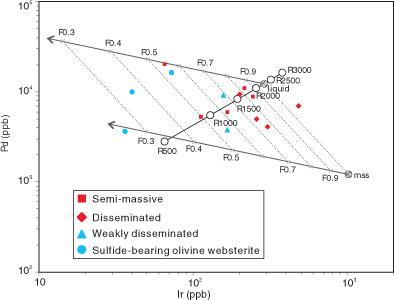当前位置:
X-MOL 学术
›
Geolog. J.
›
论文详情
Our official English website, www.x-mol.net, welcomes your
feedback! (Note: you will need to create a separate account there.)
Genesis of the Neoarchean subduction-related Taoke Ni–Cu-(PGE) sulphide deposit in the North China Craton: Constraints from Os–S isotopes and PGE geochemistry
Geological Journal ( IF 1.4 ) Pub Date : 2021-07-29 , DOI: 10.1002/gj.4223 Ai‐Ping Zhang 1, 2, 3 , Tao Sun 1, 2, 3, 4 , Zhi‐Fang Zhao 1, 2, 3, 4 , Jia‐Xi Zhou 1, 2, 3, 4 , Wan‐Ting Li 1, 2, 3 , Qun‐Jia Qi 1, 3 , Xi‐Zhu Wei 1, 3
Geological Journal ( IF 1.4 ) Pub Date : 2021-07-29 , DOI: 10.1002/gj.4223 Ai‐Ping Zhang 1, 2, 3 , Tao Sun 1, 2, 3, 4 , Zhi‐Fang Zhao 1, 2, 3, 4 , Jia‐Xi Zhou 1, 2, 3, 4 , Wan‐Ting Li 1, 2, 3 , Qun‐Jia Qi 1, 3 , Xi‐Zhu Wei 1, 3
Affiliation

|
Archean magmatic Ni-Cu-[platinum-group element (PGE)] deposits are very important and mainly associated with komatiitic rocks in intracratonic rift zones throughout the world. However, the Taoke Ni-Cu-(PGE) deposit in the North China Craton, which is the oldest (Neoarchean, 2,537 Ma) magmatic sulphide deposit in China, and is genetically related to the subduction zone. The intrusion is predominantly composed of a small ultramafic body (olivine websterite) and a much larger gabbroic body (gabbronorite). Sulphide mineralization is mainly associated with the ultramafic body with average grades of 0.66 wt% Ni, 0.62 wt% Cu and ~1 g/t PGE. Sulphides of the Taoke deposit are characterized by a chalcopyrite + pentlandite + pyrrhotite + millerite assemblage, which hosts variable amounts of platinum-group minerals. Good correlations are found for Pd versus individual Ir subgroup of platinum-group elements (IPGEs; i.e., Pd vs. Os, Ir, Ru, and Rh) and for Ir and Pd subgroup of platinum-group elements (PPGEs; i.e., Ir vs. Pt and Pd), indicating that the PGE contents of immiscible sulphide liquids in the Taoke deposit are mainly controlled by the initial PGE concentrations in the parental magma and R factor (magma/sulphide mass ratio). Based on our calculations, the initial contents of Ir and Pd in the parental magma are estimated to be 0.13 and 5.6 ppb, respectively, suggesting that the parental magma of the Taoke deposit is PGE undepleted. The multiple sulphur isotopes can provide direct indications of the source of sulphur for the Archean intrusion. The γOs(t) values and Archean crustal sulphur (three samples have anomalous Δ33S values <−0.1‰) suggest that the addition of crustal sulphur occurred in the magma. Fractional crystallization and the addition of crustal sulphur are the most likely key factors for sulphide saturation in the Taoke mafic magma.
更新日期:2021-09-02











































 京公网安备 11010802027423号
京公网安备 11010802027423号